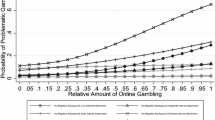Abstract
Online gambling has grown into a global social and economic phenomenon. It is, however, regarded as a risky practice, as it may be connected to the development of gambling-related disorders. Literature has shown a growing interest to determine the direction of the relationship between online gambling participation and gambling-related harm, as it raises some endogeneity concerns. This paper aims to contribute to the study of this relationship. Using data from the prevalence study of gambling users in Spain, a two-stage approach with instrumental variables is proposed to address these endogeneity concerns. An ordered probit model is then estimated to explore the correlation between online gambling participation, the intensity of participation, and the risk of developing some kind of gambling-related harm. Findings showed that online gambling had a significant impact on the odds of experiencing a gambling disorder, which worsened as online gambling participation increased.
Similar content being viewed by others
References
Canale, N., Griffiths, M. D., Vieno, A., Siciliano, V., & Molinaro, S. (2016). Impact of Internet gambling on problem gambling among adolescents in Italy: Findings from a large-scale nationally representative survey. Computers in Human Behavior, 57, 99–106.
DGOJ (2015). Estudio sobre prevalencia, comportamiento y características de los usuarios de juego de azar en España. Retrieved from http://www.ordenacionjuego.es/en/estudio-prevalencia.
DGOJ (2018). Informe anual de mercado de juego online estatal de 2018. Retrieved from http://www.ordenacionjuego.es/es/noticia-mercado-juego-online-estatal-2018.
Gainsbury, S. M. (2015). Online gambling addiction: the relationship between internet gambling and disordered gambling. Current Addiction Reports, 2(2), 185–193.
Gainsbury, S. M., Russell, A., Hing, N., Wood, R., & Blaszczynski, A. (2013). The impact of internet gambling on gambling problems: A comparison of moderate-risk and problem Internet and non-Internet gamblers. Psychology of Addictive Behaviors, 27(4), 1092.
Griffiths, M., & Barnes, A. (2008). Internet gambling: An online empirical study among student gamblers. International Journal of Mental Health and Addiction, 6(2), 194–204.
Griffiths, M., Parke, A., Wood, R., & Parke, J. (2005). Internet gambling: An overview of psychosocial impacts. UNLV Gaming Research & Review Joumal, 10(1), 27–39.
Griffiths, M., Wardle, H., Orford, J., Sproston, K., & Erens, B. (2009). Sociodemographic correlates of internet gambling: Findings from the 2007 British gambling prevalence survey. CyberPsychology & Behavior, 12(2), 199–202.
Humphreys, B., & Perez, L. (2012). Participation in Internet gambling markets: An international comparison of online gamblers’ profiles. Journal of Internet Commerce, 11(1), 24–40.
Ida, T., & Goto, R. (2009). Interdependency among addictive behaviours and time/risk preferences: Discrete choice model analysis of smoking, drinking, and gambling. Journal of Economic Psychology, 30(4), 608–621.
Philander, K. S., & MacKay, T. L. (2014). Online gambling participation and problem gambling severity: Is there a causal relationship? International Gambling Studies, 14(2), 214–227.
Stock, J., & Yogo, M. (2005). Testing for Weak Instruments in Linear IV Regression. Identification and Inference for Econometric Models: Essays in Honor of Thomas Rothenberg, pp. 80–108.
Wardle, H., Moody, A., Griffiths, M., Orford, J., & Volberg, R. (2011). Defining the online gambler and patterns of behaviour integration: Evidence from the British Gambling Prevalence Survey 2010. International Gambling Studies, 11(3), 339–356.
Wood, R., & Williams, R. (2011). A comparative profile of the Internet gambler: Demographic characteristics, game-play patterns, and problem gambling status. New Media & Society, 13(7), 1123–1141.
Wood, R., Williams, R., & Lawton, P. (2007). Why do Internet gamblers prefer on line versus land-based venues? Journal of Gambling Issues, 20, 235–250.
Wooldridge, J. M. (2010). Econometric analysis of cross section and panel data. Cambridge: MIT press.
Funding
This study received funding from the University of Oviedo.
Author information
Authors and Affiliations
Contributions
All authors contributed to the study and approved the final manuscript.
Corresponding author
Ethics declarations
Conflict of interest
The authors declare that they have no conflict of interest.
Availability of Data and Material
Data used is not public and cannot be shared.
Additional information
Publisher's Note
Springer Nature remains neutral with regard to jurisdictional claims in published maps and institutional affiliations.
Rights and permissions
About this article
Cite this article
Díaz, A., Pérez, L. Online Gambling-Related Harm: Findings from the Study on the Prevalence, Behavior and Characteristics of Gamblers in Spain. J Gambl Stud 37, 599–607 (2021). https://doi.org/10.1007/s10899-020-09966-x
Published:
Issue Date:
DOI: https://doi.org/10.1007/s10899-020-09966-x




